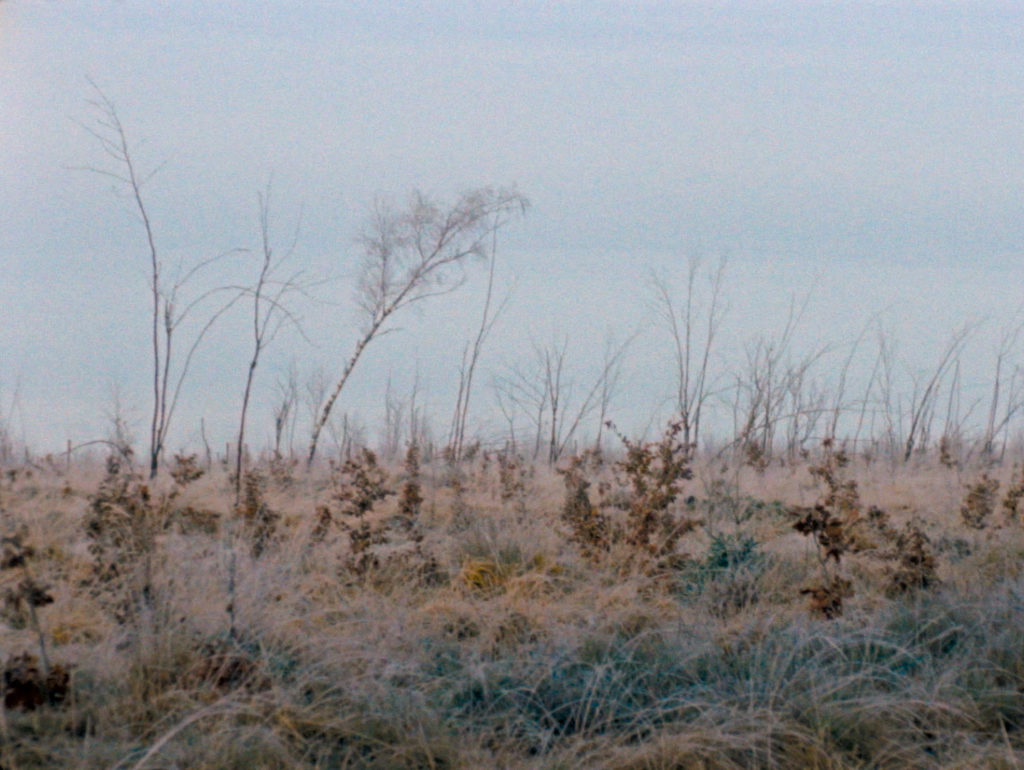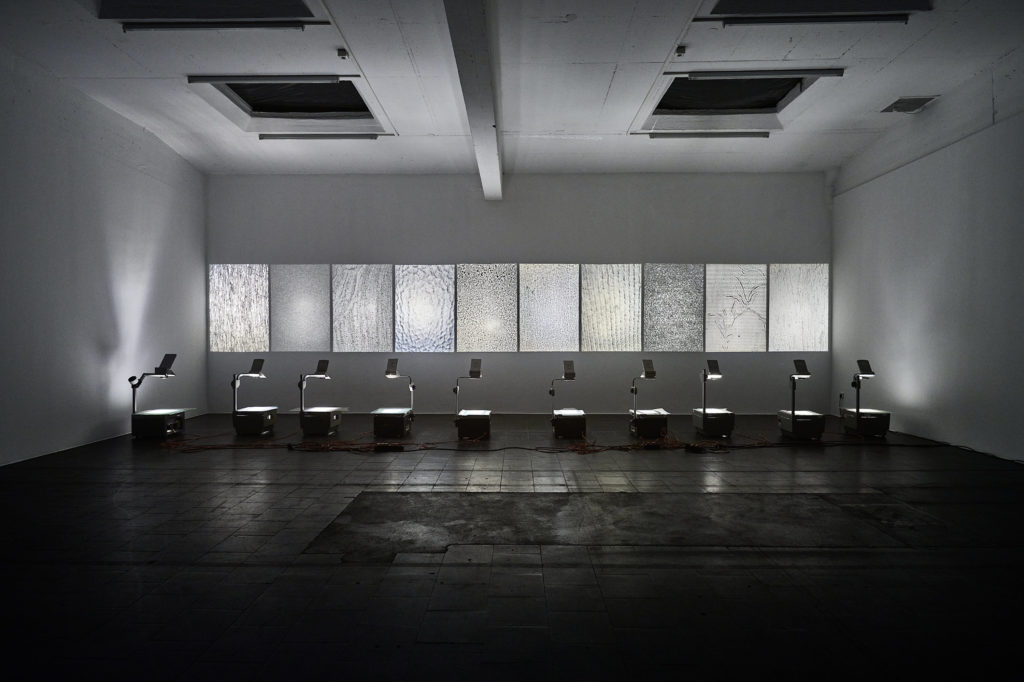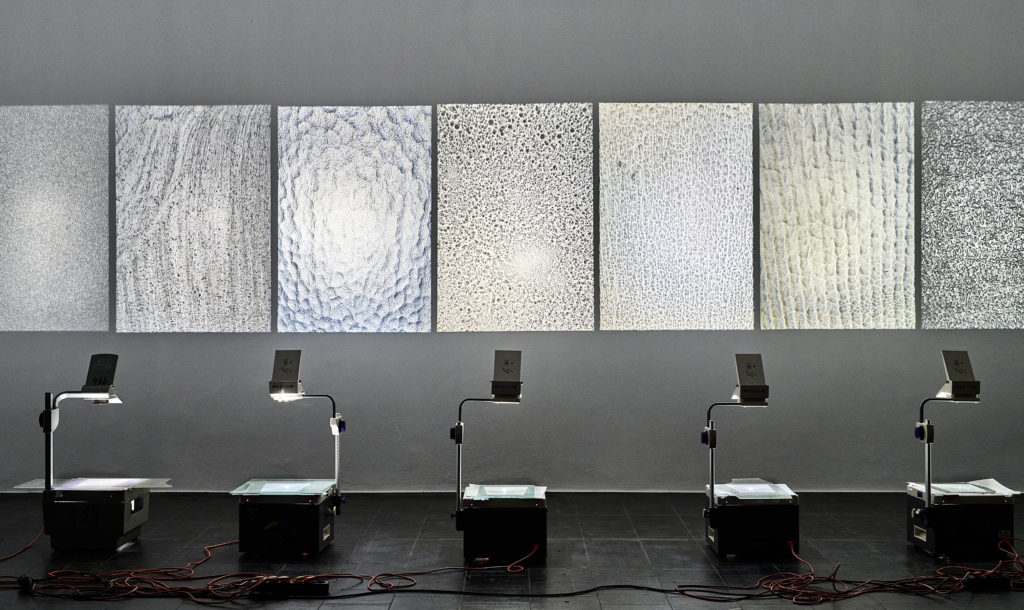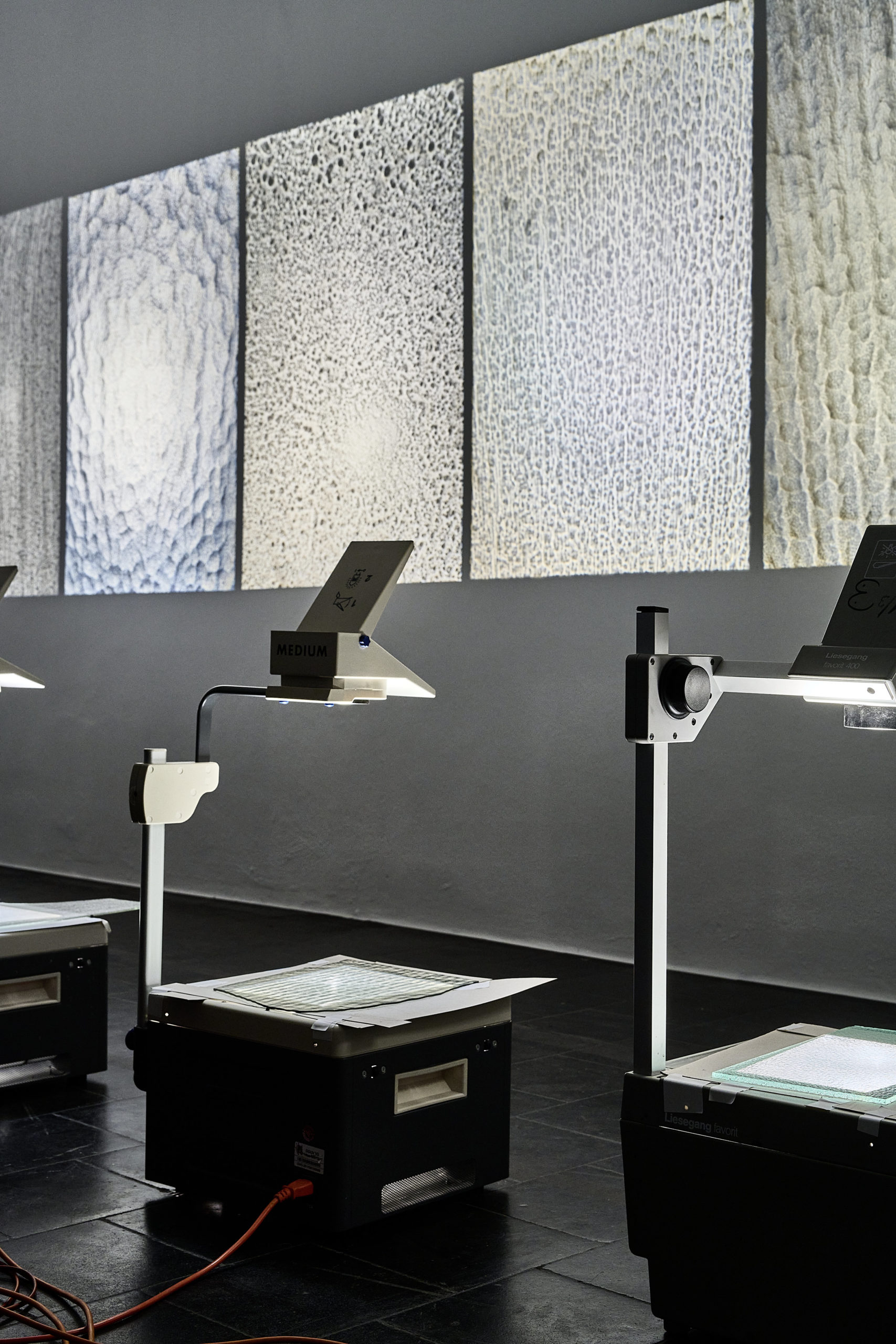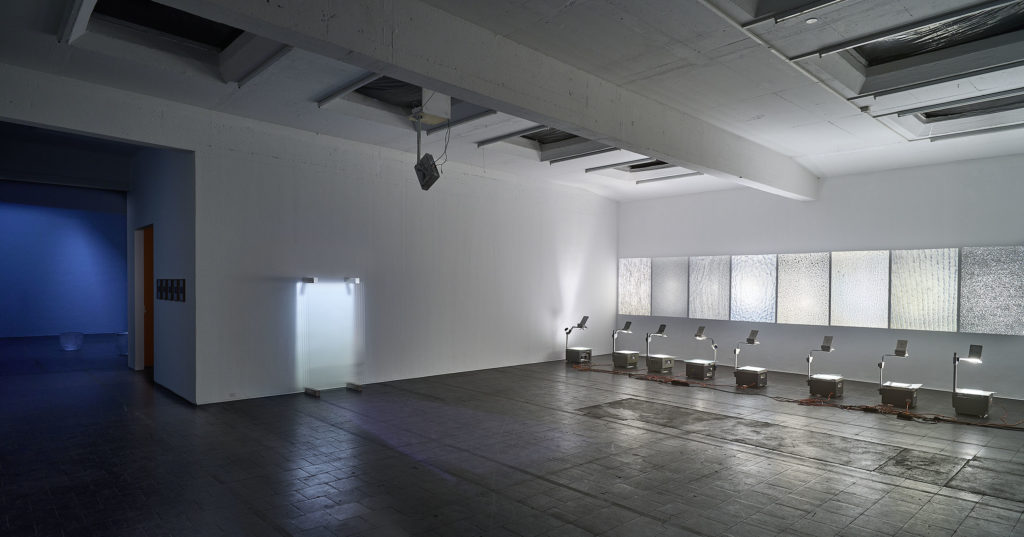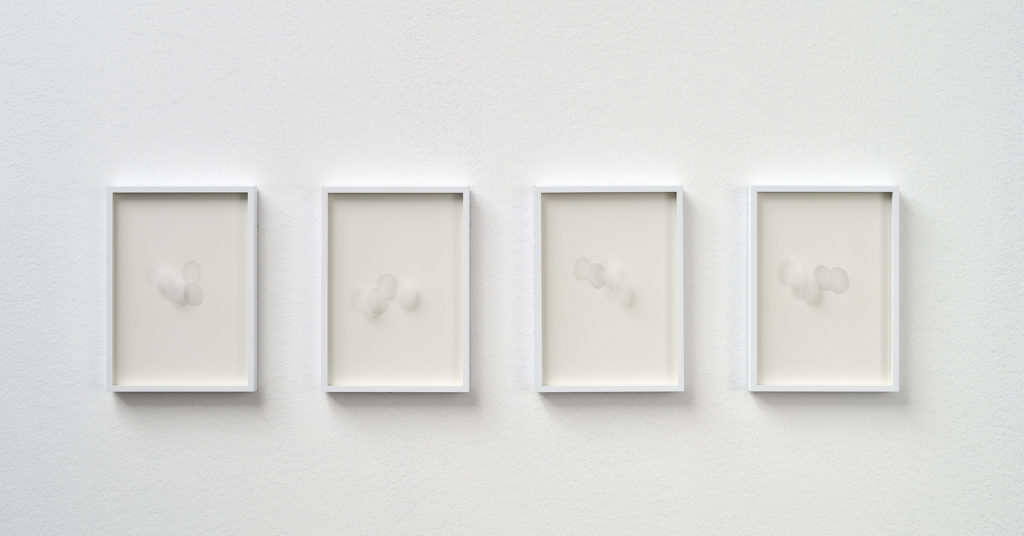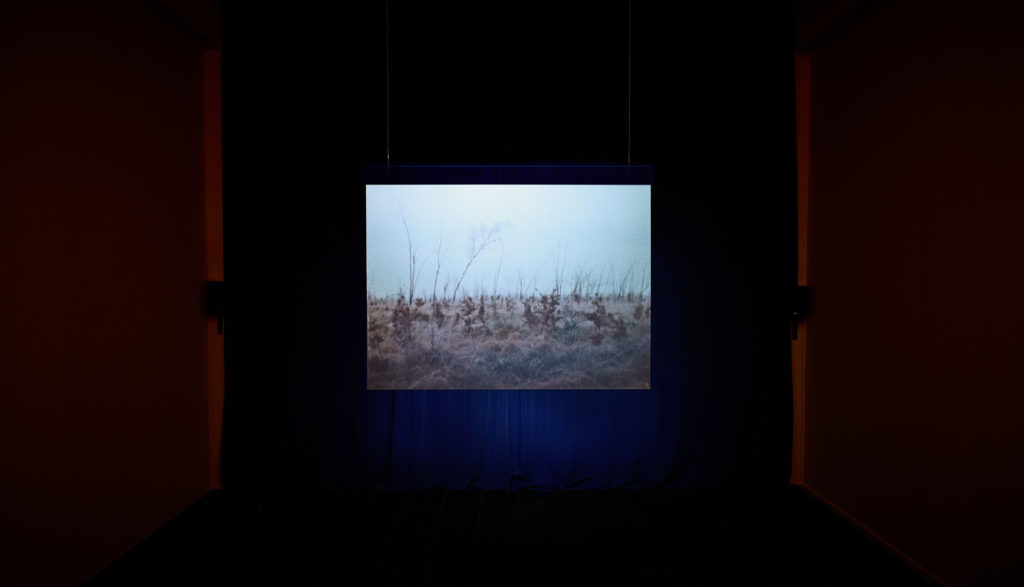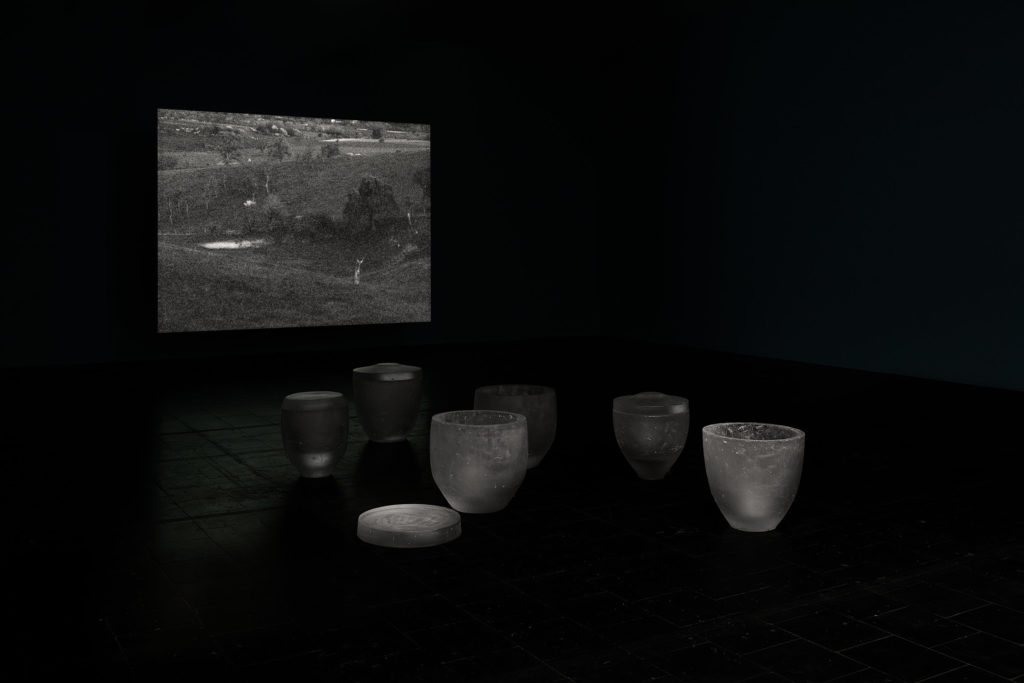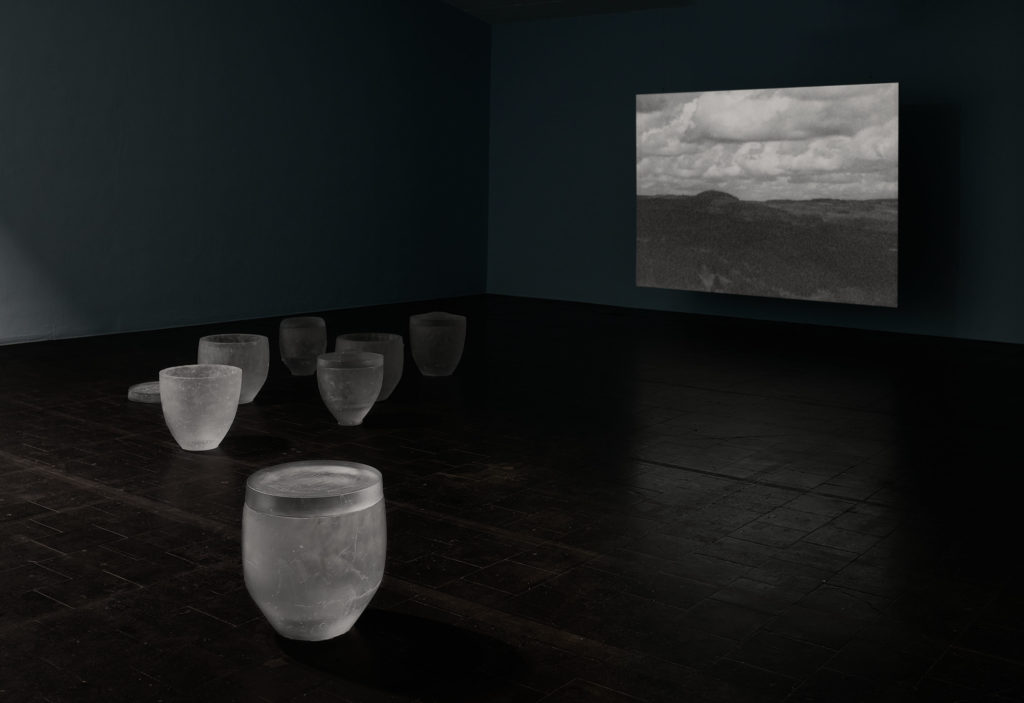A ROCK FORMATION, A STREAM, A WOOD, A CLOUD
Judith Röder
26 June - 17 October 2021
Opening: 25 June 2021
A rock formation, a stream, a wood, a cloud. That sparse and rolling landscape, marked by a harsh climate. Populated by tiny villages. Cultivating farmlands and fields. Rooting up and covering up. In every year, in every century. The people in this region are silent. The trees are old. The stones are older. They speak. They persist and survive, in that they appear insignificant. My own presence. Describing this place here and now. Seeing what there is to see. With the eye of an archaeologist that digs.
Judith Röder, Archeology of the present (1)
I want to lose myself in nature, to grow again with her, as she does, to have the stubborn tones of the rocks, the rational obstinacy of the mountain, the fluidity of the air, the heat of the sun. In a green my entire mind flows with the sap of the tree.
Paul Cézanne (2)
We must uncenter our minds from ourselves;
We must unhumanize our views a little, and become confident
As the rock and ocean that we were made from.
Robinson Jeffers (3)
The transhuman stance cannot be reached by correcting the decidedly human or anthropocentric stance through a turn to its inhuman or nonhuman counter pole, but only by turning to a basis where this opposition no longer applies and where instead insight into the deep connectedness between the human condition and the features of the world is foundational.
Wolfgang Welsch (4)
In his text “Art Transcending the Human Pale – Towards a Transhuman Stance” Wolfgang Welsch names examples of artists who articulate a symbiotic relationship to the world in their artworks. In doing so, they question the anthropic principle: a view of the world that sees it as shaped and determined by human beings from the ground up. Instead, they created works that go beyond the opposition of subject and object in the direction of an intimate, close relationship with the world. In these works of art, the human being is a part of the world and not just an observer or a conqueror. The author finds this participatory – not oppositional – relationship to the world in the artworks of Walter de Maria, John Cage, Morton Feldman but also in East Asian art traditions. At the end of the text he tells a remarkable Chinese fable about a painter who worked over a picture for a very long time. Because of this work, he became old and lonely. When he finally finished, he asked the few friends who were left to visit him. They came and saw a painting of a landscape with several fields and a path that led between them to a house on a hill. As soon as the friends formed their views, they wanted to reveal them to the artist, but they could no longer find him among them – he had disappeared. Eventually they spotted him in his own picture as he walked up the hill to the house, opened the door and turned back to face them. He waved his hand and closed the small door tightly behind him. Welsch interprets this story as showing a transition of the relationship between the man and the world as a relation of opposition to the one of inherence, of belonging. The painter moved through many landscapes and increasingly experienced himself not as an observer but as part of these landscapes. He has become someone who no longer dwells among people as usual (which is why he seems to have “disappeared”) and perceives himself as part of nature, as someone that exists in a symbiotic relation to it.
A similar artistic approach can be found in the artworks by Judith Röder. She too “disappears” in her pictures and “inhabits” them like the painter from the fable. Using different materials and techniques, she introduces us to nature that goes beyond the specifically human and subjective. In her films, made with a 16 mm analogue Bolex camera, she presents to us sequences of images that she took in the region where she’s from, the Vulkaneifel – an area of low mountains in western Germany between the cities of Trier and Koblenz. The forests of the Eifel hide small round lakes that appeared as a result of volcanic activity in the region dating back to 50 million years ago. In the films they are accompanied by views of forests, grasslands, stones and streams. Through the use of a specific camera the images have a grainy structure, which makes them more material, almost sculptural. Pattern-like structures of stones and trees sometimes don’t allow for a clear recognition of the direction, we feel lost, wondering which way is up and which is down, like in the images of earth by Dubuffet. All of this makes us feel immersed in the materiality of the image. The composition of images is simple but at the same time precise, the artist doesn’t romanticize the landscape, traces of human presence are rarely there, romantic inscription of subjectivity in natural phenomena doesn’t appear (Footnote: Although of course we might presume a certain personality of artistic figure behind the work – but this is different from content of the work being about this personality/subjectivity). The order of images doesn’t fall into a logical narrative, we do not know what to expect next, what image will be shown after the one we are watching now, why a certain image is at the beginning and why another one is at the end. An element of surprise endures. Maybe we could even say, transposing what Morton Feldman once said, “The goal is not to compose but to project images into time, free from compositional rhetoric” (5)? If a story is told here then it is not a usual one or maybe there is no story, no narrative structure at all, but ‘a sequence’, a ‘proto-juxtaposition’, an ‘ur-montage’. A manifestation of full artistic freedom allowing a certain degree of randomness: something that appears to be not determined by human planning or the narrative logic. The camera the artist uses does not allow for full control of the image. That’s why the artist created a series of texts, also present in this booklet, called “Entgangene Filmbilder” (“Missed cinematic images”), collecting the images she in the end did not take because of changed weather conditions or specific features of shooting with an analogue camera (for example, there is no light-sensitive emulsion at the beginning and end of the film spool, so these images can sometimes not be captured on film, even though the shutter button has been pressed).
This particular approach results in a quite unique experience: the more we watch these images, the more we will feel ourselves introduced into their world, drawn to it and welcomed by it. We feel as if we are increasingly becoming a part of the world that reveals itself, pulled into the flow of shapes and colours, moving within it and immersing ourselves in it. We become more like participating elements than judging observers of what we see. We slide into a no longer oppositional but participatory relationship with the world. The idea of the Cartesian ego, disembodied and detached from the environment, becomes an absurdity; the subject object division becomes much less relevant, less appealing. We begin to share the sensitive perception of the artist who writes: “In the time of the recording I am completely with the place, the light, the movement, the image. I lived in the present.”
The symbiotic relation here is achieved through heightened perceptual experience, which is also visible in other artworks in the show, exposing perceptual mechanisms related to the experience of glass installations and sculptures. A good starting point for understanding these artworks is the philosophy of Maurice Merleau-Ponty. His analysis of sensual experience highlights the fact that in the act of perception we enter a reciprocal relation with the perceived: we are open to the outside world, receive “something” from it, but at the same time, we add “something” from us, we organize it “according to ourselves”. The reality in which we participate is thus a reality co-created by us. We come into contact with reality and react to it, thus outlining a certain primal, sensual sense of the world. Merleau-Ponty explains this relation through an analysis of the specific spatial-motor structure of the human body. Neither the body nor the senses exist outside the flux of time and shared materiality, and so each has its own dynamism, its own pulsation and style that manifest in the interaction. In his philosophy Merleau-Ponty insists on the existence of a dynamic preconceptual layer of our encounter with the surrounding world, the field of sensual experience in which we are interconnected with the environment. He underlines that this type of experience is different from the conceptual one, when we think and “fix” what we saw by means of concepts, thus effectively “immobilizing” and objectifying the phenomena we interact with. In his fantastic essay on Cezanne he highlights the role of art in illuminating this preconceptual level of experience. He writes:
“We forget the viscous, equivocal appearances, and by means of them we go straight to the things they present. The painter recaptures and converts into visible objects what would, without him, remain closed up in the separate life of each consciousness: the vibration of appearances which is the cradle of things. Only one emotion is possible for this painter—the feeling of strangeness—and only one lyricism—that of the continual rebirth of existence.” (6)
The artworks of Judith Röder also expose these ephemeral qualities, perceptually they are in permanent motion and transition, developing and composing themselves through ambulant perception in a manner that is not predictable from their physical or geometrical structure alone. The work is then rather what emerges when you walk around and perceive; in the midst of this experience, something exceeding human expectation and comprehension arises.
An important part of the exhibition is a new film production by the artist about the moor landscape of the High Fens, or Hohes Venn. This nature park on the German-Belgian border seems inaccessible to humans: wooden walkways lead for kilometres through the otherwise impassable terrain. An attempt to use the land for forestry was not possible; the trees could not survive in the wetland. Areas like this one play a very important role in combating the climate crisis. Peatlands are the most effective carbon sink of all land habitats: in one hectare of bog with a 15-centimetre-thick layer of peat there is about as much carbon as in a hundred-year-old forest of the same size. When peat bogs are drained by humans, the carbon that has been bound in the peat for thousands of years comes into contact with oxygen and oxidizes. This not only releases huge amounts of CO2 into the atmosphere, but also nitrous oxide (N2O), which is more than 300 times more harmful to the climate. Regardless of this, the worldwide destruction of moorlands through drainage and peat removal continues. Moorlands originally covered 1.5 million hectares, which made up 4.2 per cent of Germany’s land area. Today 95 per cent of it is dead – that is, drained, pitted, built on, used for agriculture or forestry.
Coming back to the anecdote about the painter disappearing within his own artwork, there is a paradox to this story: the transition from a subject-object relationship to a relationship of inherence, of symbiosis, seems to be not representable in a painting. For pictures are things to be observed and the observer stands opposed to the picture in the relationship of subject to object. Welsch proposes to solve this paradox in the following way:
“The transition from an oppositional to a symbiotic world-relationship can only become evident in a picture when occurring as an event. [...] By observing the picture intensively for a long time and understanding the painter’s endeavour better and better, the friends probably did realize that what was shown in the picture was not a landscape as we usually see it opposed to us, but a landscape that envelops us – and first and foremost has enveloped the painter. [...] By intensively contemplating the picture, the friends finally realized that the painting articulated this symbiotic way of being and relationship to the world. The picture in fact possessed the power to make this other attitude evident, to convey it to the observers too. In becoming aware of the essence of the picture, the friends not only got a sense of this other relationship but, to a certain degree at least, must – through the power of the artwork – have been converted to it.” (7)
Adhering to this solution we would like to encourage you to see this exhibition and these artworks as an ‘event’ – as having transformational power to bring you closer to the symbiotic experience of your environment. For that however you would need to prepare, mostly – dedicate more time to the exhibition itself. Come in and stay with the artworks longer than you would usually, do not conceptualize and analyse immediately, try to find a comfortable, relaxed position for your body, allow the works to envelop in front of you and take you in. Treat them as self-evolving organisms. And continue with the experience afterwards – specifically for the audience of this exhibition (apart from a rich public programme including a concert, reading group sessions and a symposium dedicated to Lynn Margulis), we have prepared an invitation to take your own trip into the national park Hohes Venn. Use the plan, hints and instructions that you will find on our website, to extend the ‘event’ of the exhibition in time and space in accord with Bashô’s famous advice to his disciples: “Learn about a pine tree from a pine tree, and about a bamboo plant from a bamboo plant.” In our case it would be:
Learn about a rock formation from a rock formation.
Learn about a stream from a stream.
Learn about a wood from a wood.
Learn about a cloud from a cloud.
A rock formation.
A stream.
A wood.
A cloud.
Aneta Rostkowska, exhibition curator
The exhibition is accompanied by a Flyer with poems by the author Elke Erb.
Editions and postcards are available for the exhibition. More information here.
Click here for a virtual tour of the exhibition.
Referenzen / References:
- Judith Röder, Vulkaneifel. Artist book, StrzeleckiBooks 2020, 238.
- Conversations avec Cézanne, ed. by P. M. Doran, Macula, Paris 1978, 124.
- Robinson Jeffers, Carmel Point, in: The Collected Poetry of Robinson Jeffers, ed. by Tim Hunt, vol. 3 (1938–62), Stanford University Press 1991, 399.
- Wolfgang Welsch, Art Transcending The Human Pale – Towards A Transhuman Stance, in: Aesthetics of Transhumanity – Beauty Nature Universe. International Yearbook of Aesthetics, ed. by Ken Ichi Sasaki, International Association for Aesthetics 2001, 22.
- Morton Feldman, Liner Notes, in Give My Regards to Eighth Street. Collected Writings by Morton Feldman, ed. by B. H. Friedman, Exact Change, Cambridge 2000, 3-7 (6).
- Maurice Merleau-Ponty, Cézanne’s Doubt, in: The Merleau-Ponty Reader, ed. by Ted Toadvine and Leonard Lawlor, Northwestern University Press, Evanston, Illinois 2007, 69-84 (77). German translation: Der Zweifel Cézannes, in: Maurice Merleau-Ponty, Das Auge und der Geist. Philosophische Essays, Felix Meiner Verlag, Hamburg 2003, 3-27 (16).
- 7. Wolfgang Welsch, op. cit., 18-20.
Judith Röder, born in 1981 in the Vulkaneifel, lives and works as a freelance artist in Cologne, Höhr-Grenzhausen and the Eifel. In 2019 she completed her postgraduate studies (diploma with distinction) at the Academy of Media Arts (KHM) Cologne. Before that, she studied Fine Art / Glass at the Institute for Artistic Ceramics and Glass (IKKG) at Koblenz University. She has received multiple awards and grants, including the Kunstpreis Zonta Mainz (2020), Stipendium Stiftung Kunstfonds (2020/21), Publikationsförderung MWWK Land Rheinland-Pfalz (2020), Stipendium Alexander Tutsek-Stiftung (2020), Kunstpreis der Initiative Kirche und Kultur Wiesbaden (2012), Stuttgarter Filmwinter Wand 5 Award (2011), Ramboux-Preis der Stadt Trier (2010) and Stipendium August-Müller-Stiftung (2009). In 2018 and 2019 she was artist-in-residence at AiRWRO in Wrocław. Her work has been shown in the following art spaces and biennials, Museum für Angewandte Kunst (MAK) Frankfurt a.M. (2011), Stadtmuseum Simeonstift Trier (2011), Kunst-Station Sankt Peter Köln (2013), Het Glazen Huis Lommel (2013), International Glass Biennale Strasbourg (2015), BWA SiC! Gallery Wrocław (2015), 2D → Glass Biennale Vilnius (2016), European Glass Context Bornholm (2016), Responsive – International Light Art Project Halifax (2017), EVI Lichtungen – International Light Art Biennale Hildesheim (2018), Interference – International Light Art Project Tunis (2018), See Djerba – International Media Art Project Djerba (2019), Neuer Kunstverein Wuppertal (2020), among others.
Funding and Support
Stiftung Kunstfonds
Ministerium für Kultur und Wissenschaft des Landes Nordrhein-Westfalen
Kulturamt der Stadt Köln
Deltax Wirtschafts- und Steuerberatungsgesellschaft mbH
Hotel Chelsea
Partner
Photoszene United
Images
1 — Judith Röder: Hohes Venn, 2021 (Filmstill)
